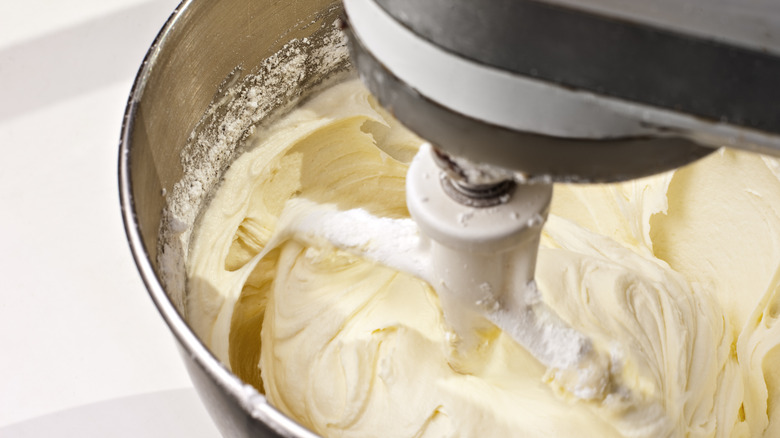The Common Mistake You Want To Avoid When Baking With Cream Cheese
Cream cheese is baking's unsung hero. Cream cheese puts the "cheese" in cheesecake and even makes for delicious and drool-worthy frosting. It's also used in countless other recipes from cookie bars to Oreo balls to delicious brownie swirls. However, despite its ubiquity, bakers can find the ingredient somewhat difficult to work with. Who hasn't whipped up a batch of cream cheese frosting only to find clumps of the cheese muddling up its smooth consistency? If you find yourself struggling to incorporate cream cheese into your baked goods, there is one key mistake you might be making that could be putting a damper on your baking endeavors. Using cold cream cheese, straight from the fridge, is a surefire way to clump up whatever baking project you're working on.
Instead of using cream cheese straight from the fridge, you should instead use room temperature cream cheese. Of course, room temperature is a fuzzy term, but it generally falls between 68 degrees Fahrenheit and 72 degrees Fahrenheit. Your cream cheese should be soft enough to indent with the pad of your finger, but should not be melting. Making sure your cream cheese is at the proper temperature will help prevent your recipes from curdling, and will help to emulsify your ingredients, which is key to producing smooth frostings and fluffy cakes.
Mixing up your cream cheese
Why is emulsification so important when baking? Put simply, emulsification is the process by which multiple immiscible liquids come together to form an even and uniform mixture. This process is vital for baking as it allows the combined ingredients to create air bubbles. These bubbles expand while cooking in the oven, making for a perfect, fluffy final product. Room temperature cream cheese will also make it easier to achieve smooth, even, and fluffy frostings (no lumps). However, if you want your ingredients to properly emulsify, you should bring all of your dairy ingredients to room temperature, including your eggs. Having your eggs, butter, and cream cheese all at room temperature will make them easier to combine, as the ingredients are less solid than they are when they're cold. This thinning out makes your ingredients blend together more easily than if they were solid.
So how do you go about bringing your cream cheese to room temperature? Well, you could go the old fashioned route, and sit it on the counter to warm up for an hour. But this can be inconvenient for bakers on the go. Luckily, there are a few ways to bring your cream cheese to room temperature in minutes. These methods range from microwaving your cream cheese to submerging it in a bowl of warm water, and they work well in a pinch. However, you will want check that your cream cheese is warmed all the way through, as these methods can produce a partially heated product.
Keeping your cream cheese safe
Of course, a delicious carrot cake with cream cheese frosting is all for naught if your cream cheese isn't safe to use. Though cream cheese can safely sit on the counter for two hours, don't let it sit at room temperature for longer than that, as it could become susceptible to foodborne pathogens such as salmonella. And this is no good. For this reason, you should avoid leaving your cheese out overnight to warm up. Instead, you can opt for faster warming methods, or keep track of the length of time your cheese is exposed to room temperature environments.
This also goes for baked goods containing cream cheese. Some baked goods, such as unfrosted cakes or cakes with butter or shortening based frostings can safely sit out of the fridge for several days at a time. However, any baked good containing cream cheese frosting, or with a cream cheese base (such as cheesecake), should be kept in the fridge at all times to avoid premature spoilage. Additionally, any baked good containing cream cheese should not be taken out of the fridge for more than two hours at a time, as prolonged exposure to warm temperatures can make your tasty treat vulnerable to bacteria growth. You should also place your confection in an airtight container in order to maintain its fresh taste and texture. Keeping these pointers in mind will help you to make the most of your cream cheese, and your baking efforts.


